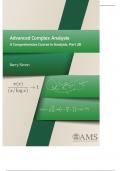Advanced Complex Analysis
A Comprehensive Course in Analysis, Part 2B
Barry Simon
,Advanced Complex Analysis
A Comprehensive Course in Analysis, Part 2B
,
, http://dx.doi.org/10.1090/simon/002.2
Advanced Complex Analysis
A Comprehensive Course in Analysis, Part 2B
Barry Simon
Providence, Rhode Island
, 2010 Mathematics Subject Classification. Primary 30-01, 33-01, 34-01, 11-01;
Secondary 30C55, 30D35, 33C05, 60J67.
For additional information and updates on this book, visit
www.ams.org/bookpages/simon
Library of Congress Cataloging-in-Publication Data
Simon, Barry, 1946–
Advanced complex analysis / Barry Simon.
pages cm. — (A comprehensive course in analysis ; part 2B)
Includes bibliographical references and indexes.
ISBN 978-1-4704-1101-5 (alk. paper)
1. Mathematical analysis—Textbooks. I. Title.
QA300.S526 2015
515—dc23
2015015258
Copying and reprinting. Individual readers of this publication, and nonprofit libraries
acting for them, are permitted to make fair use of the material, such as to copy select pages for
use in teaching or research. Permission is granted to quote brief passages from this publication in
reviews, provided the customary acknowledgment of the source is given.
Republication, systematic copying, or multiple reproduction of any material in this publication
is permitted only under license from the American Mathematical Society. Permissions to reuse
portions of AMS publication content are handled by Copyright Clearance Center’s RightsLink�
service. For more information, please visit: http://www.ams.org/rightslink.
Send requests for translation rights and licensed reprints to reprint-permission@ams.org.
Excluded from these provisions is material for which the author holds copyright. In such cases,
requests for permission to reuse or reprint material should be addressed directly to the author(s).
Copyright ownership is indicated on the copyright page, or on the lower right-hand corner of the
first page of each article within proceedings volumes.
�
c 2015 by the American Mathematical Society. All rights reserved.
The American Mathematical Society retains all rights
except those granted to the United States Government.
Printed in the United States of America.
�
∞ The paper used in this book is acid-free and falls within the guidelines
established to ensure permanence and durability.
Visit the AMS home page at http://www.ams.org/
10 9 8 7 6 5 4 3 2 1 20 19 18 17 16 15
, To the memory of Cherie Galvez
extraordinary secretary, talented helper, caring person
and to the memory of my mentors,
Ed Nelson (1932-2014) and Arthur Wightman (1922-2013)
who not only taught me Mathematics
but taught me how to be a mathematician
,
,Contents
Preface to the Series ix
Preface to Part 2 xv
Chapter 12. Riemannian Metrics and Complex Analysis 1
§12.1. Conformal Metrics and Curvature 3
§12.2. The Poincaré Metric 6
§12.3. The Ahlfors–Schwarz Lemma 14
§12.4. Robinson’s Proof of Picard’s Theorems 16
§12.5. The Bergman Kernel and Metric 18
§12.6. The Bergman Projection and Painlevé’s Conformal
Mapping Theorem 27
Chapter 13. Some Topics in Analytic Number Theory 37
§13.1. Jacobi’s Two- and Four-Square Theorems 46
§13.2. Dirichlet Series 56
§13.3. The Riemann Zeta and Dirichlet L-Function 72
§13.4. Dirichlet’s Prime Progression Theorem 80
§13.5. The Prime Number Theorem 87
Chapter 14. Ordinary Differential Equations in the Complex
Domain 95
§14.1. Monodromy and Linear ODEs 99
§14.2. Monodromy in Punctured Disks 101
§14.3. ODEs in Punctured Disks 106
vii
,viii Contents
§14.4. Hypergeometric Functions 116
§14.5. Bessel and Airy Functions 139
§14.6. Nonlinear ODEs: Some Remarks 150
§14.7. Integral Representation 152
Chapter 15. Asymptotic Methods 161
§15.1. Asymptotic Series 163
§15.2. Laplace’s Method: Gaussian Approximation and
Watson’s Lemma 171
§15.3. The Method of Stationary Phase 183
§15.4. The Method of Steepest Descent 194
§15.5. The WKB Approximation 213
Chapter 16. Univalent Functions and Loewner Evolution 231
§16.1. Fundamentals of Univalent Function Theory 233
§16.2. Slit Domains and Loewner Evolution 241
§16.3. SLE: A First Glimpse 251
Chapter 17. Nevanlinna Theory 257
§17.1. The First Main Theorem of Nevanlinna Theory 262
§17.2. Cartan’s Identity 268
§17.3. The Second Main Theorem and Its Consequences 271
§17.4. Ahlfors’ Proof of the SMT 278
Bibliography 285
Symbol Index 309
Subject Index 311
Author Index 315
Index of Capsule Biographies 321
, Preface to the Series
Young men should prove theorems, old men should write books.
—Freeman Dyson, quoting G. H. Hardy1
Reed–Simon2 starts with “Mathematics has its roots in numerology, ge-
ometry, and physics.” This puts into context the division of mathematics
into algebra, geometry/topology, and analysis. There are, of course, other
areas of mathematics, and a division between parts of mathematics can be
artificial. But almost universally, we require our graduate students to take
courses in these three areas.
This five-volume series began and, to some extent, remains a set of texts
for a basic graduate analysis course. In part it reflects Caltech’s three-terms-
per-year schedule and the actual courses I’ve taught in the past. Much of the
contents of Parts 1 and 2 (Part 2 is in two volumes, Part 2A and Part 2B) are
common to virtually all such courses: point set topology, measure spaces,
Hilbert and Banach spaces, distribution theory, and the Fourier transform,
complex analysis including the Riemann mapping and Hadamard product
theorems. Parts 3 and 4 are made up of material that you’ll find in some,
but not all, courses—on the one hand, Part 3 on maximal functions and
H p -spaces; on the other hand, Part 4 on the spectral theorem for bounded
self-adjoint operators on a Hilbert space and det and trace, again for Hilbert
space operators. Parts 3 and 4 reflect the two halves of the third term of
Caltech’s course.
1 Interview
with D. J. Albers, The College Mathematics Journal, 25, no. 1, January 1994.
2 M.Reed and B. Simon, Methods of Modern Mathematical Physics, I: Functional Analysis,
Academic Press, New York, 1972.
ix




